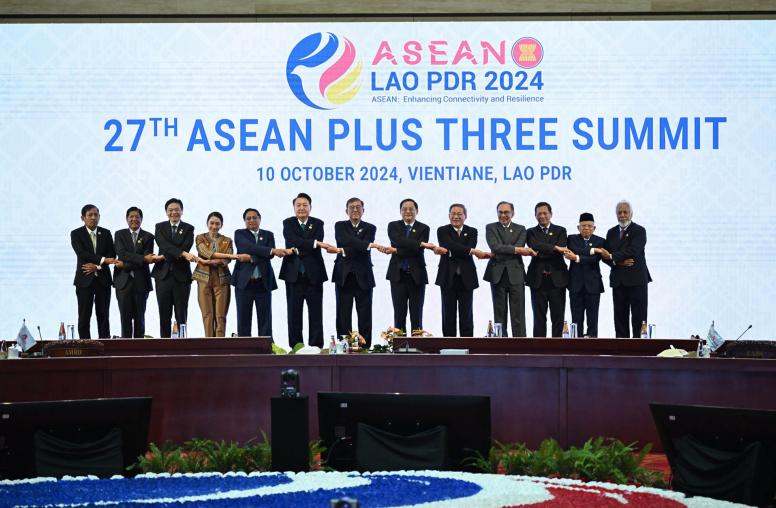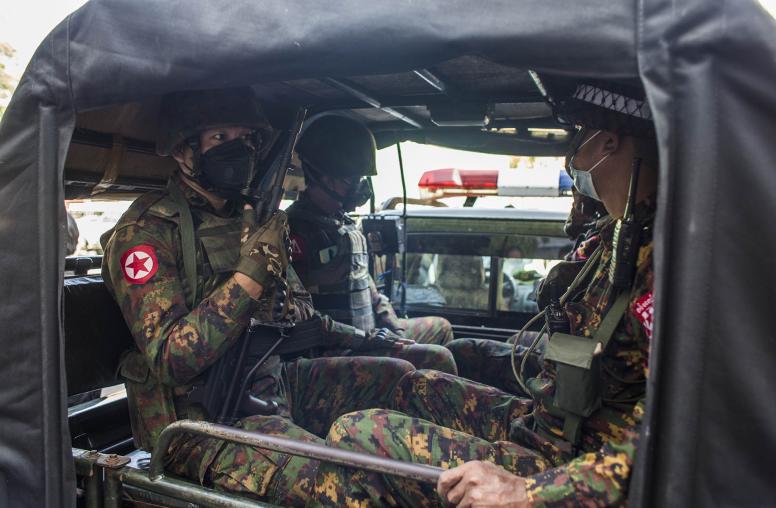China Using Pandemic Aid to Push Myanmar Economic Corridor
As millions of dollars in assistance flow to Myanmar, the costs to peace and governance appear to mount.
From almost the moment Myanmar detected its first case of COVID-19 on March 23, China jumped to aid its neighbor to the south. China’s army, navy, and government agencies, as well as companies, showered nearly every level of Myanmar’s government and military with health assistance. The question for Myanmar civil society groups was whether the help came with strings attached. On May 21, they got their answer: After a phone call between Chinese leader Xi Jinping and Myanmar’s President U Win Myint about COVID-19 response and Chinese assistance, Xi moved to a second agenda item—the implementation of 33 cooperative economic agreements signed during his historic visit to Myanmar in January. Of particular concern: co-construction of the multi-billion-dollar China-Myanmar Economic Corridor.

The unexpected, high-level engagement increases worry that Chinese aid is tied to Myanmar fast-tracking tens of billions of dollars of infrastructure that will more tightly bind the two countries’ economies—projects that run through conflict areas. The pressure comes as Myanmar’s internal peace process has collapsed, leaving the government and ethnic armed organizations without agreement on how to share the benefits of this development. A prominent ethnic political party leader has stated publicly that advancing the China-Myanmar Economic Corridor without consulting local ethnic communities will most certainly fuel further violence. Already, over the past year, fighting has broken out repeatedly between ethnic groups and the government along the transportation corridor, with key dissident forces demanding to be included in any planned development.
During Xi’s visit to Myanmar, the two countries signed agreements related to three critical components of the economic corridor, a proposed transportation route and series of industrial zones linking China’s southwestern provinces to the Indian Ocean: the Kyaukphyu Special Economic Zone, the Cross-Border Economic Cooperation Zones, and the Yangon New City Development. Subsequently, the Chinese ambassador expressed strong support for resuming work on the Myitsone dam. The $3.6 billion project at the headwaters of the Irrawaddy River was suspended in 2011 over its environmental and social impacts as well as broad local opposition. The project is adjacent to conflict zones in Myanmar’s northern Kachin State.
Together these projects are critical to the development of southwestern China, where over $100 billion has been invested in industry that depends on a viable logistics and energy corridor through Myanmar. For Myanmar, their value remains highly questionable, particularly given the lack of progress in resolving the world’s longest-running civil war. The U.S. has made significant investments in seeking to end the fighting, while also supporting major efforts to strengthen governance and democracy in the country.
Internal Conflicts
Amid their fights for autonomy, ethnic armed organizations are concerned that—without any progress toward peace—the Myanmar government and military will further encroach on their territories on the back of the Chinese-funded developments.
Fighting has continued in the north in Shan and Kachin States, where the Cross-Border Economic Cooperation Zones are slated to occupy several square kilometers of ethnic lands. In Rakhine State fighting between the Arakan Army and the military has spread from its most northern part along the Bangladesh border south several hundred kilometers to the proposed site of the Kyaukphyu Special Economic Zone. The Arakan Army, fighting for autonomy of the country’s ethnic Arakan population, was established in 2009 by Arakan youth leaders in the China-Myanmar border area. It launched an attack in Rakhine State in 2019, rapidly gaining a foothold in this majority Arakan part of the country.
Meanwhile, in the country’s largest city, Yangon, civil society, environmental groups, and members of parliament continue to raise concerns about the third project—the Yangon New City Development—which could face environmental disasters given its location in a flood plain. They have also pointed out the project’s financial burden, arguing the funds could be better applied to existing needs in the Yangon municipal area.
Companies to the Rescue
Over the past two months, Chinese companies and government agencies have mobilized countless donations of health aid to the Myanmar government. Press releases tracked by the author place the total aid in excess of $4.5 million—but this likely misses much of the funding. Of particular significance, the companies behind the four above-mentioned projects have provided COVID-19 assistance to the Myanmar government, including agencies with direct approval authority for their plans.
- China’s State Power Investment Company, the proponent of the suspended Myitsone Dam project, made significant donations to the Kachin State government, the Myanmar Ministries of Electricity and Energy, the Ministry of Information, the Ministry of Commerce, and the Ministry of Health and Sports.
- Firms promoting the cross-border zones scheme, including the Shanghai based Pengxin Company, which has a $200 million investment in the cross-border projects, contributed to a donation of nearly $1 million of supplies to the Myanmar government. The Hengyi Company, which is backing the Kachin cross-border zones, donated around $280,000 to almost a dozen government agencies. Meanwhile sub-provincial Chinese governments involved in the cross-border projects all made significant donations to their local Myanmar government counterparts.
- The proponent of the Kyaukphyu Project, the CITIC Group, pledged nearly $80,000 in health assistance to Rakhine State through the Rakhine Ethnic Affairs minister based in Yangon.
- China Communications Construction, which is involved in the Yangon New City project, donated tens of thousands of dollars of surgical masks, glasses, and other medical supplies to the Yangon Region Government.
The companies all engaged in public relations fanfare around their contributions, stressing in Burmese and Chinese media hope that their investments can soon move ahead.
The Corridor and COVID Recovery
In late April, the Myanmar government announced its COVID-19 Economic Relief Plan (CERP), to address the pandemic’s impact on the country’s frail economy. Within a few days, the Chinese ambassador rushed to meet with the Ministry of Finance and Planning to discuss CERP supporting the three fulcrum projects of the China-Myanmar Economic Corridor. Meanwhile, the Chinese Ministry of Commerce and China Development Bank have created a plan to provide support, including preferential loans to “distressed” projects of the Belt and Road Initiative. That only sparked further worry that rather than getting people back to work and supporting local business, scarce resources may be allocated to questionable infrastructure projects.
Back in China, growing pressure to re-start the economy has spurred bold plans for development of China’s western provinces, and the more-than $1.3 trillion flagged for economic recovery emphasizes the west. Since the 1980s, Chinese policy advisors have stressed that access to the Indian Ocean through Myanmar is critical for western development. More than $100 billion has already been spent on the scheme, which Chinese experts assess has made only limited progress over the past five years.
Under intense pressure, the western Yunnan Province is pushing to implement Xi’s agreements, developing concrete—though still non-public—plans. According to China’s official planning body, the Yunnan Government in April approved the “Implementing Plan for Yunnan Province’s Participation in Construction of the China-Myanmar Economic Corridor (2020-2030).” Through this policy, Yunnan hopes to help support China’s response to questions raised about the relevance and sustainability of the Belt and Road Initiative beyond COVID-19.
Amid the push, local Chinese governments in China-Myanmar border towns linked to the Cross-Border Economic Co-Operation Zones—including Ruili, Lincang, and Tengchong—are hurrying to win agreements from Myanmar counterparts to get construction started even before COVID-19 is contained. Between March and April, they pressed Myanmar to establish working committees, approve feasibility studies and take concrete steps to allocate several square kilometers in the border area to the cross-border industrial developments.
The projects’ immediate future will naturally depend on whether Myanmar’s response to COVID-19 is effective. While Chinese aid has generated publicity, health professionals, local leaders, and key political figures say it isn’t reaching targeted communities, particularly in Rakhine State. One expert from Rakhine told the U.S. Institute of Peace that none of the assistance given in Yangon has—or could—reach the most vulnerable communities across the growing parts of Rakhine State affected by fighting.
Stronger Pressure
President Xi’s phone call has applied a new level of pressure to Myanmar-Chinese relations with a clear message from the top: These projects must move forward immediately. This is what China—benefactor, investor, and economic powerhouse—needs. Myanmar, of course, has many other priorities as the country tries to reset its economy. Not least are addressing internal conflict and strengthening governance in a country still struggling to recover from decades of military rule. Advancing the array of Chinese-backed projects right now could undermine those goals.
For the United States and other international stakeholders who have invested significantly in supporting governance, democracy, and peace in the country, there is a clear interest in helping Myanmar tackle the underlying drivers of violence before these projects further complicate what is already one of the world’s most complicated array of conflicts. What is needed most as Myanmar combats COVID-19 are robust coordination and response mechanisms that ensure that aid is channeled properly to communities in need, and that economic recovery is not unduly influenced by the competing interests of external actors.



